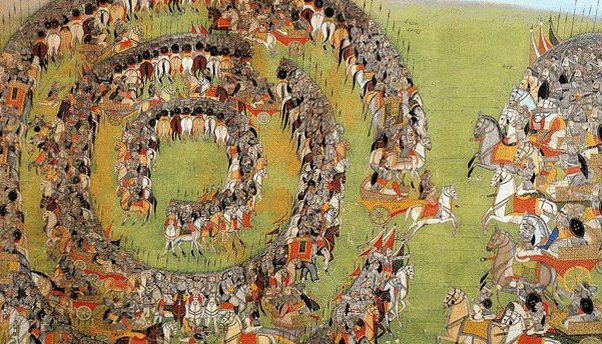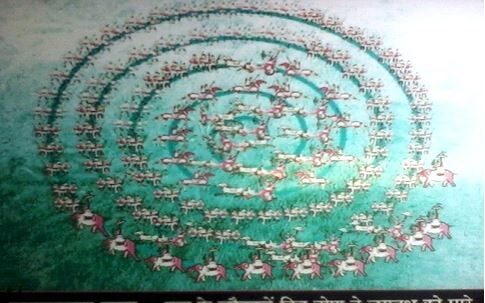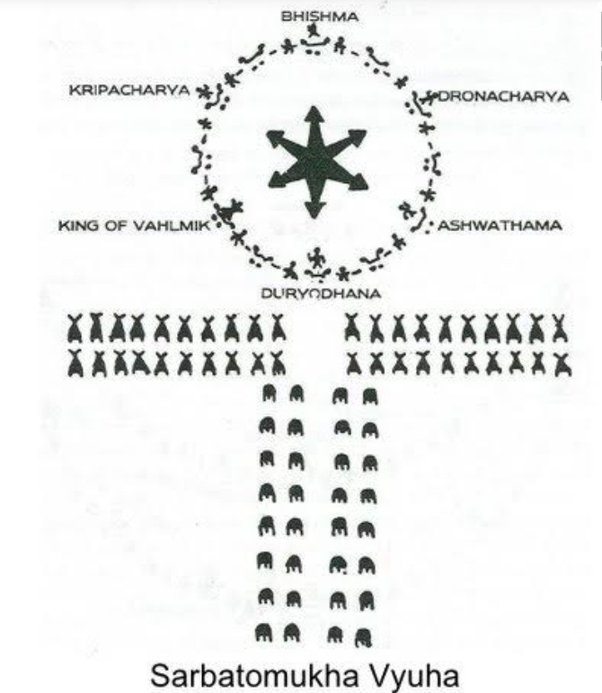What was Vyuh Rachana in ancient times ?

The positioning of soldiers in a particular order for the battle is called Vyuh Rachnaa. Vyuh is mentioned in the mythological text Mahabharata. In the war of Mahabharata, many types of Vyuhas were created by Pandavas and Kauravas. Vyuh means “group made of soldiers” or “a part of the army”.

Things to keep in Mind while arranging Vyuh
While creating a special array, these things had to be kept in mind how should the army be spread? What should be the distribution of various military departments? That is, which several departments should be located at each place, which generals should stand at which main places and conduct military operations, etc. Considering all these things very carefully, the formation aimed to keep an efficient system of both attack and defense operations. In war, the armies of both sides used to create arrays and defeat each other’s side warriors by bringing them into that array.
This array is visible when seen from the sky. For example, there is a Kraunch array, so when seen from the sky, soldiers will be seen standing like Kraunch birds. Similarly, on seeing the Chakravyuh from the sky, a military formation is seen like a rotating wheel.

Vyuh Racahana was used in Mahabharata battle
In Mahabharata, you must have heard only the name of Chakravyuh. But in the war of Mahabharata, many types of scene creation are mentioned. To fight the war, the side or the opposition used to create an array according to their own. The meaning of array formation is how to make the soldiers stand in front. Let’s know about some special Vyuh used in Mahabharata.

Garuda Vyuh
You must have seen the picture of the Garuda bird. This giant bird is the vehicle of Lord Vishnu. In war, soldiers are lined up in front of the opposing army in such a way that when seen from the sky, an eagle-like figure is visible. This is called Garuda Vyuh. In the Mahabharata, this array was created by Bhishma Pitamah.
Kraunch
Kraunch is a species of stork. The size of this array was like this bird. In Mahabharata, this Vyuh was created by Yudhishthira.
Makarvyuh
In ancient times there was an aquatic animal named Makar. Makara had the head of a crocodile but had horns like the horns of a goat, a body like an antelope and a snake, a tail like a fish or a peacock, and legs like a panther. Timingila and Makara are often mentioned together in Vedic literature. But probably here the meaning of the formation of an array will be from Magar and not from Capricorn. In the Mahabharata, this Vyuh was created by the Kauravas.
Kachua
In this, the army is arranged like a tortoise.
Ardhachandrakar
You already understand the meaning of Ardha Chandra. When the military formation was like a half-moon, it was called a crescent formation. This Vyuh was created by Arjuna in response to the Garuda Vyuh of the Kauravas.
Mandalakar
Mandala means circular or circular. This array was formed in a circular form. In the Mahabharata, this array was created by Bhishma Pitamah. In response to this, the Pandavas created Vraj Vyuh and divided it.

Chakravyuh
On seeing Chakravyuh from the sky, a military formation like a rotating wheel is visible. On seeing this Chakravyuh, one can see the way to go inside it, but the way out is not visible. You must have seen Spiral, it is just like that. In Mahabharata, this Vyuh was created by Guru Drona.
Chakrashakat
After the ruthless killing of Abhimanyu in the Mahabharata war, Arjuna had taken an oath that he would kill Jayadratha tomorrow before sunset. Then Guru Dronacharya created this Vyuh to save Jayadrath. But by the cleverness of Lord Krishna, Jayadrath came out of that array and was killed.
Vajra
Vajra is a kind of weapon. It was of two types – Kulish and Ashani. Its upper three parts are made diagonally. The middle part is thin. But it is very heavy. Its shape is like the Vajra of Lord Indra. In the Mahabharata, this Vyuh was created by Arjuna.
Aurmi
In response to Vraj Vyuh of Pandavas, Bhishma created Aurmi Vyuh. In this array, the whole army was decorated like the sea. The Kaurava army attacked the Pandavas in the same shape as the waves seen in the ocean.
Shringataka
Arjuna created the Shringatka Vyuh in response to the Aurami Vyuh of the Kauravas. This array looked like a building. Probably this would be called the Vyuh with three peaks… Apart from this, the mention of Sarvatobhadra and Suparna Vyuh is also found.
